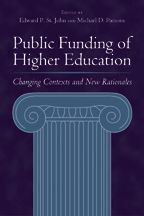
Reviews
This original and substantial book will be valuable to state and institutional higher education policymakers and administrators.
An unparalleled, meticulously detailed look at how colleges in three states are responding to high-stakes performance funding systems.
Book Details
Acknowledgements 1. Introduction Widespread Adoption of Performance Funding The Different Forms of Performance Funding Conceptualizing How Performance Funding Works Chapter Contents and Preview of
Acknowledgements 1. Introduction Widespread Adoption of Performance Funding The Different Forms of Performance Funding Conceptualizing How Performance Funding Works Chapter Contents and Preview of Findings 2. Research Perspectives, Questions, and Methods Existing Scholarship on the Impacts of Performance Funding and Its Limitations
Policy Instruments
Organizational Changes
Student Outcomes
Obstacles to Effective Functioning
Unintended Impacts
Overall Limitations Enlisting Insights from Other Bodies of Literature
Performance Management in Public Agencies
Policy Design: Policy Instruments and their Strengths and Weaknesses
Data-Driven Decision Making and Organizational Learning in Higher Education
Policy Implementation
Principal-Agent Theory Conceptual Framework Research Questions Research Methods 3. Policy Instruments and their Immediate Impacts Financial Incentives
Little Initial Impact on Institutional Finances
Explaining the Low Initial Impact on Institutional Finances
Perceived Impact of Financial Incentives on Institutional Behavior Communication of State Program Goals and Methods
State Communication
College Communication
Variations in Awareness of State Goals and Methods
Perceived Impact of Awareness of State Goals and Methods on College Efforts Communication of Institutional Performance on the State Metrics
State Communication of Institutional Performance
College Communication of Institutional Performance
Variations in Awareness of Institutional Performance
Perceived Impact of Awareness of Institutional Performance Building Up Institutional Capacity to Respond to Performance Funding
What State Officials Were Doing
Institutional Officials' Assessment of the State Effort to Build Capacity Disaggregating Our Main Patterns
Differences by State
Differences by Type of Institution: Community Colleges and Universities
Differences by Estimated Organizational Capacity of Institutions Summary and Conclusions 4. Organizational Learning in Response to Performance Funding Deliberative Processes Used to Respond to Performance Funding
General Administrative Deliberative Processes
Special Purpose Deliberative Structures
Informal Deliberative Structures Variations in Deliberative Processes
Variations by State
Variation by Type of Institution
Variations by Expected Institutional Capacity Aids and Hindrances to Deliberation
Organizational Commitment and Leadership
Communication and Collaboration
Time and the Opportunity to Deliberate on New Policies and Practices
Timely and Relevant Data Variations in Aids and Hindrances
Differences by State
Differences by Type of Institution
Differences by Institutional Capacity Summary and Conclusions 5. Changes to Institutional Policies, Programs, and Practices Perceptions about the Impact of Performance Funding
Ratings of the Impact of Performance Funding on Institutional Changes
Reasons Given for Not Rating the Impact of Performance Funding "High"
The Joint Influence of Several Different Factors Changes in Academic Policies, Practices, and Programs
Developmental Education Changes
STEM-Field Academic Changes
General Curricular Changes
Changes to Instructional Techniques: Technology/Online Education Student Services Changes
Advising and Counseling
Tutoring and Supplemental Instruction
Orientation and First-Year Programs
Tuition and Financial Aid Policies
Registration and Graduation Procedures
Restructuring Student Services Departments and Staffing
Other Student Services Changes Isomorphism and the Institutionalization of Campus Changes Disaggregating Our Main Patterns
Differences by State
Differences by Institutional Type
Differences by Institutional Capacity Summary and Conclusions Chapter 6: Student Outcomes Descriptive Data
Indiana
Ohio
Tennessee Multivariate Study Findings
Studies Specific to Our Three States
Studies of Performance Funding outside Our Three States
U. S. Performance Funding Outcomes Outside of Higher Education Summary and Conclusions Chapter 7: Obstacles to Effective Response Student-Body Composition
Inadequate Preparation for College
Non-Degree Seekers
Lower Socioeconomic Status (SES) and Its Financial Burdens Inappropriate Performance Funding Measures Insufficient Institutional Capacity Insufficient State Funding of Higher Education Institutional Resistance to Performance Funding Insufficient Knowledge of Performance Funding Variations Within Our Main Findings
Differences by State
Differences by Institutional Type
Differences by Institutional Capacity Summary and Conclusions Chapter 8: Unintended Impacts of Performance Funding Restrictions of Student Admission
General Restrictions
Raising Admission Requirements
Selective Student Recruitment
Directing Institutional Aid to Better Prepared Students Weakening of Academic Standards
Lowering Academic Demands in Class (Grade Inflation)
Reducing Degree Requirements Compliance Costs
Cost of Improving Institutional Research Capacity
Increased Workload Reduced Institutional Cooperation Lower Faculty and Staff Morale Less Faculty Voice in Academic Governance Narrowing of Institutional Mission Variations Within Our Main Findings
Differences by State
Differences by Institutional Type
Differences by Institutional Capacity Summary and Conclusions Chapter 9: Summary and Conclusions Key Findings
Policy Instruments
Organizational Learning
Institutional Changes
Student Outcomes
Obstacles to Responding to Performance Funding
Unintended Impacts
Differences within These Main Patterns Implications for Policy
Reducing Unintended Negative Impacts
Reducing Obstacles to Effectively Responding to Performance Funding
The Importance of Extensive Institutional Consultation and Periodic Review Implications for Research Concluding Thoughts Appendixes Appendix A: The Nature and History of Performance Funding in Indiana, Ohio, and Tennessee Appendix B: Interview Protocol for State Officials Appendix C: Interview Protocol for Community College Administrators and Faculty Appendix D: Interview Protocol for University Administrators and Faculty Notes References Index







